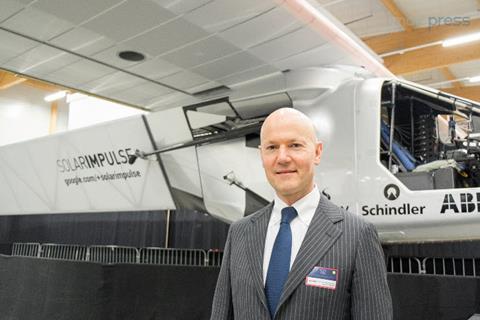Agostino Galvagni, chief executive, and Michel Rohr, lead underwriter reveal why and how the Zurich-based commercial insurer priced the risks linked to a solar-powered airplane

Swiss Re Corporate Solutions confirmed it is insuring Solar Impulse 2, the first-ever solar-powered airplane capable of flying around the world, for a value of €24.6m (30m CHF), of which hull insurance for damage to the airplane is €9.9m (12m CHF).
The firm, along with other insurers, initially rejected Solar Impulse’s application for insurance some years ago owing to a lack of data on risks linked to a solar-powered airplane.
However, it later decided to cover the plane’s total value, basing its underwriting decisions on information and data that had been generated by the Solar Impulse team and backed up by the pilots and co-founders, Bertrand Piccard and André Borschberg.
Following the launch of Solar Impulse 2 in Payerne, Switzerland, Agostino Galvagni (pictured), chief executive officer at Swiss Re Corporate Solutions said: “Typically, prototypes are considered uninsurable because they are new, there is no past data that could help us quantify the risks and determine the insurance price.
“That’s why initially we were uncomfortable. But the team at Solar Impulse provided us with lots of information. In spite of missing industry data, after discussions with Solar Impulse and based on the [pilot’s] high level of knowledge we became comfortable enough to provide insurance.”
He added: “In addition to representing the potential we have in the renewable energy field overall, we decided to insure Solar Impulse for two other reasons. First, we believe Solar Impulse stands for innovation; and innovation is one of the major value propositions of Swiss Re Corporate Solutions.
“The other reason is the concept of sustainability itself – Swiss Re has been elected as the most sustainable insurance company as measured by the by the Dow Jones Sustainability Indexes.”
Michel Rohr, the firm’s lead underwriter and client executive for aviation explained that the premium was calculated by “pricing [the risk] over similar types of risks [associated with ‘normal’ airplanes].”
“Then we loaded the premium with an uncertainty factor,” he added. “We would probably have charged 3% for the risk if it had been a normal airplane, but in this instance, we had to add a loading [percentage] because it was not a normal airplane.
Solar Impulse 2 will attempt the first-ever round-the-world trip by a solar airplane next year. In order to achieve that, the pilots will have to fly up to five consecutive days and nights when crossing the Pacific without any fuel.




















No comments yet